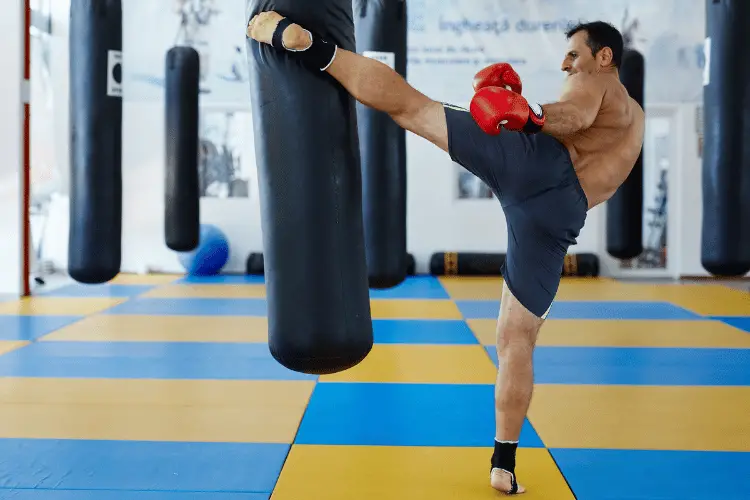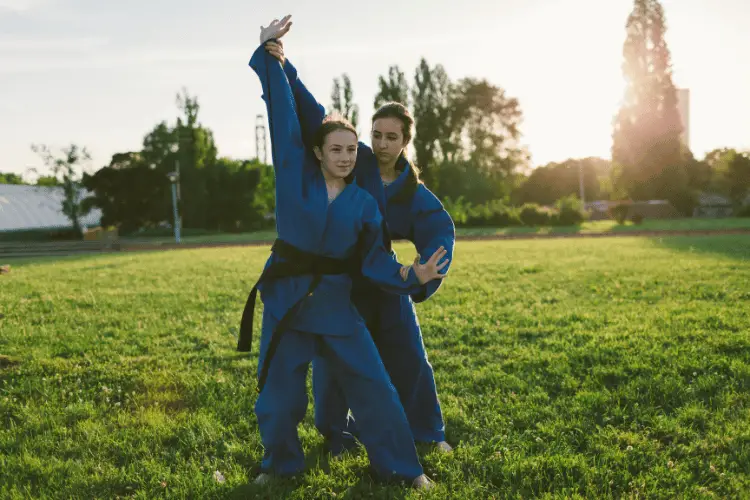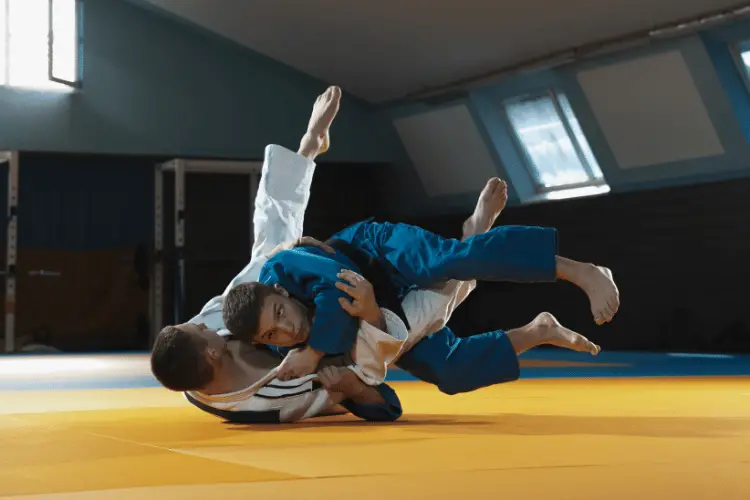Martial arts training improves your agility, flexibility, strength, endurance, and cardiovascular health. Traditional exercises in the gym will also improve your fitness.
So, why not combine the two?
Mixing fitness and martial arts training has become a norm among fitness geeks because it’s an all-in-one deal. Read on to know more about the benefits of mixing them.
Is Martial Arts Training a Good Way to Get Fit?
Honestly, participating in martial arts training will make you feel like you’re not working out at all.
Now don’t get me wrong, martial arts training is brutal. But it isn’t the same mental game as traditional weightlifting.
Here are several reasons why you should consider combining martial arts training with your regular exercise regimen:
- Provides Social Opportunities
The gym is a highly social space, especially if you participate in the following classes:
- Pilates
- High-Intensity Interval Training (HIIT)
- Circuit Training
- Bootcamp
Fortunately, martial arts training is a social workout too. Since coaches conduct classes in a group setting, it allows you to meet others who share the same interests as you.
As such, you’ll have someone with whom you can share your concerns and struggles. Plus, you wouldn’t feel alone in your fitness journey.
According to a 2010 study, martial arts training can become an instrument to improve your social development. Apparently throwing punches and kicks at your fellow classmates improves your communication with them.
- Martial Arts Offer a Variety of Exercises
Martial arts training is challenging as it provides a different experience in every session. There are new warm-up techniques, drills, and stretches every time, so you won’t get bored.
Additionally, each martial arts discipline has its own style and techniques. A Muay Thai training session looks much different than a Capoeira session.
- Martial Arts Provide a Full-Body Workout
You’re wrong if you think that martial arts training doesn’t work out your whole body.

Considering that martial arts training involves repeated muscular actions that use your upper and lower extremities (constantly tied together with your core muscles), it definitely exercises every part of your body.
For example, Nihon-Kempo is a full-body martial art that combines the abilities of Kung-Fu, Brazilian Jiu-Jitsu, Judo, and Karate. It consists of many exercises, such as:
- Striking and kicking (atemi-waza)
- Reverse joint locks (kansetsu-gyakutori-waza)
- Blocking (uke-waza)
- Ground combat (ne-waza)
All of this helps thoroughly develop your body.
As such, you can consider martial arts training as an all-in-one deal. It helps you burn fat and calories while increasing overall mobility and muscle strength.
Various Types of Martial Arts
There are multiple types of martial arts training that you can try. The first type is fighting martial arts that concentrate on groundwork, locking, and throwing.
These kinds of martial arts training work out your upper extremities.
Second, grappling martial arts focus on sweeps, clinch, and submission holds. Most of these focus on working out your lower extremities, especially your thighs and legs.
Lastly, there are martial arts that involve meditation. Below is a table that summarizes all of these:
| Striking Martial Arts (Focuses on Upper Body) | Grappling Martial Arts (Focuses on Lower Body) | Martial Arts Involving Meditation |
| Japanese Jiu-Jitsu | Capoeira | Tai Chi |
| Karate | Muay Thai | Qigong |
| Kung Fu | Taekwondo | Baguazhang |
| Suntukan | Kickboxing | Aikijujutsu |
| Lethwei | Kalaripayattu | Xing Yi Quan |
| Judo | Tang Soo Do | Hapkido |
What Are the Benefits of Martial Arts Training?
General fitness training has lots of benefits that martial arts training also provides, such as the following:
- Strengthens Muscle
Martial arts training involves high-intensity anaerobic and aerobic workouts that utilize every muscle group in your body.
Almost all martial arts training contains strength training, so you’ll develop muscles. A few examples of these exercises are the following:
- Squat
- Lunges
- Push Ups
- Innumerable core exercises
If you’re consistent in doing these exercises, you’ll see and feel the results just as you would if you were hitting the gym. But the martial arts aspect is way more fun and demanding, which helps with the motivation part. Let’s be honest, gyms can just be boring sometimes.
- Improves Speed and Agility
There are plenty of sprinting and footwork drills involved in martial arts training. Here are a few exercise examples that help enhance your reaction speed:
- Kicking Paddles
- Focus Mitts
- Reaction Ball Training
On the other hand, sprinting drills will be your go-to if you want to focus on your overall quickness.
Your martial arts coach will probably also make you conduct plyometric exercises or jump training. These are aerobic exercises that focus on your lower extremities.
When you pair high-intensity, powerful movements like sprinting with plyometrics, you’ll become as extremely agile in no time. These explosive exercises can make your feet feel lighter when moving. And they give you a ton of confidence in everyday life.
- Amplifies Coordination
Martial arts improve your coordination. Coordination can be simply explained as a timed and sequential firing of muscles to complete an action. Coordination is what makes dancers and other performers look graceful.
Coordination is what makes trained martial artists so deadly.
These methods help improve your coordination:
- Repetition of movements and skills – When learning a new technique, you’ll likely do it slowly and repeatedly so your brain will master it.
- Focus and concentration – Since martial arts training demands your full attention, you become more conscious of your movements, making you more coordinated.
- Doing complex movements – When performing complicated techniques, you break them down into smaller steps, enabling you to practice combining everything in an organized manner.
- Develops Balance
Aikido and Bagua Zhang are two martial art types that develop your balance. Both emphasize precise movement and body control.

Aikido is a Japanese martial art centered on taijutsu, a method of using your body for self-defense. As such, doing this will involve many joint manipulation and break-falling.
On the other hand, Bagua Zhang is a martial art that practices circle walking. Practitioners will walk in circles while holding static postures and other techniques.
But all forms of martial arts develop balance. Otherwise they’d fall over every time they threw a kick.
- Boosts Endurance and Stamina
Martial arts training will boost your endurance and stamina as well.
Most martial artists incorporate cardio workouts that go beyond the usual running routines. Aside from using the treadmill, they also do sprint interval training.
In a kickboxing class I took in college, we would punch the wall for 60 seconds at a time. It felt like my heart was going to explode.
Sprinting and running increases your muscle strength, burns fat, and expands your lung capacity. These factors are essential if you want to build your overall endurance.
Jumping rope is also an effective method. It can do wonders for your cardiovascular performance, plus it works out your core, legs, and arms.
- Enhances Accuracy
When starting martial arts training, your coach will likely strive to increase your accuracy through practice.
You become consistent and more accurate when you repeat the moves over and over again.
The most common example of this is hitting the striking pad repeatedly every session. Over time, you’ll learn how to punch and kick with accuracy without missing a shot.
When you’ve become more advanced in your martial arts training, you’ll eventually try combining different attacks. It improves your accuracy because you’ll know when to strike at the right time and in the right area.
- Intensifies Power
Power is vital in martial arts because it allows you to generate faster and more impactful movements.
Since you constantly use both speed and strength when engaging in martial arts training, it increases your overall power.
Your coach will enlighten you on how you can apply the proper amount of stress in the correct way at the proper frequency. It’s because too much stress in your muscles can cause severe injuries.
Does Martial Arts Training Have Mental Benefits?
You might want to consider trying out martial arts training to boost your mood.
Below are the reasons why martial arts help you mentally:
- Relieves Stress
Martial arts training encourages you to practice meditation, mindfulness, and deep breathing. As such, it keeps you focused while remaining alert and calm.
Fighting styles like Karate, Tai Chi, and Kung Fu incorporate meditation into their training. This is because meditation relaxes the muscles and helps you control overwhelming emotions.
- Promotes Emotional Regulation
Martial arts training allows you to regulate your emotions. A study showed that Tai Chi, often referred to as “meditation in motion,” promotes emotional stability.

Another Chinese martial art, Qigong, practices cultivating life force through meditation, guided imagery, and breathing techniques. So, it also helps regulate your emotions.
A study proved that people who practice Qigong experienced reduced anxiety and depressive symptoms. It improved their overall emotional well-being as well.
In general, those training in the martial arts will feel less overwhelmed by their environment and feel more at ease.
- Boosts Confidence
Since martial arts training can help you burn lots of calories, you’ll probably get into some of the best shape of your life.
Additionally, martial arts training challenges your mind too. You’ll experience lots of setbacks, but you’ll eventually learn how to bounce back from them, no matter how hard things get.
Lastly, you have people around you, especially your coach, who will recognize all the hard work you put into your craft. As such, you become more confident, and begin to really look forward to your future training sessions and progress.
- Induces Happiness
All sorts of physical activities boost the production of endorphins in our brains. These are the feel-good neurotransmitters responsible for making us feel relaxed whenever we are in pain or under stress.
On top of that, you’ll also feel happier when you practice martial arts because it’s a social activity. You’ll get to meet new friends from all different ages, races, and personal backgrounds.
That said, you’ll be able to build healthy relationships with other people, making you happy.
- Encourages Personal Development
In general, martial arts training helps you become a master of your own mind and emotions. So, they enable you to develop greater emotional stability and assertiveness.
Moreover, since there are many types of martial arts, there are lots of things you can learn. As such, they challenge you to constantly grow not only physically, but also mentally.
Martial arts training encourages you to move through these mental blocks too. Your coaches, peers, and other people will give you the confidence to make positive changes in your life.
Final Thoughts
So, mixing fitness and martial arts is totally worth it.
You can totally get into it just for the fitness aspect. I absolutely believe that when we hit a rut in the gym, we should change things up and this is the perfect option.
Additionally, martial arts training improves your mental well-being too. Just knowing that you’re that much able to defend yourself is reassuring.
And you may be surprised when you see how fit you get compared to your regular gym routine.
References
- https://www.library.pima.gov/wp-content/uploads/sites/6/2021/03/Martial-Arts-9468.pdf
- https://www.ncbi.nlm.nih.gov/pmc/articles/PMC3761807/
- https://medium.com/martial-arts-unleashed/best-stretching-exercises-for-increasing-flexibility-top-10-25e5507af712
- https://files.eric.ed.gov/fulltext/EJ973956.pdf
- https://www.webmd.com/fitness-exercise/what-is-anaerobic-exercise#:~:text=Anaerobic%20exercises%20include%20high%2Dintensity,maintain%20muscle%20and%20lose%20weight.
- https://www.webmd.com/fitness-exercise/what-are-aerobic-exercises
- https://www.healthline.com/health/exercise-fitness/plyometric-exercises
- https://www.physio-pedia.com/Coordination_Exercises#:~:text=Coordination%20is%20the%20ability%20to%20select%20the%20right%20muscle%20at,direction%2C%20timing%20and%20muscular%20tension.
- https://www.britannica.com/sports/aikido
- https://www.webmd.com/fitness-exercise/running-to-lose-weight
- https://www.helpguide.org/articles/healthy-living/the-mental-health-benefits-of-exercise.htm
- https://www.researchgate.net/publication/350636819_Mushin_in_Martial_Arts_and_Insights_from_Neuroscience
- https://www.frontiersin.org/articles/10.3389/fpsyg.2019.00091/full#:~:text=Our%20results%20supported%20that%20Tai,in%20improving%20emotional%20regulation%20ability.
- https://www.ncbi.nlm.nih.gov/pmc/articles/PMC6519567/
- https://www.mayoclinic.org/healthy-lifestyle/stress-management/in-depth/exercise-and-stress/art-20044469#:~:text=Physical%20activity%20may%20help%20bump,contribute%20to%20this%20same%20feeling.



